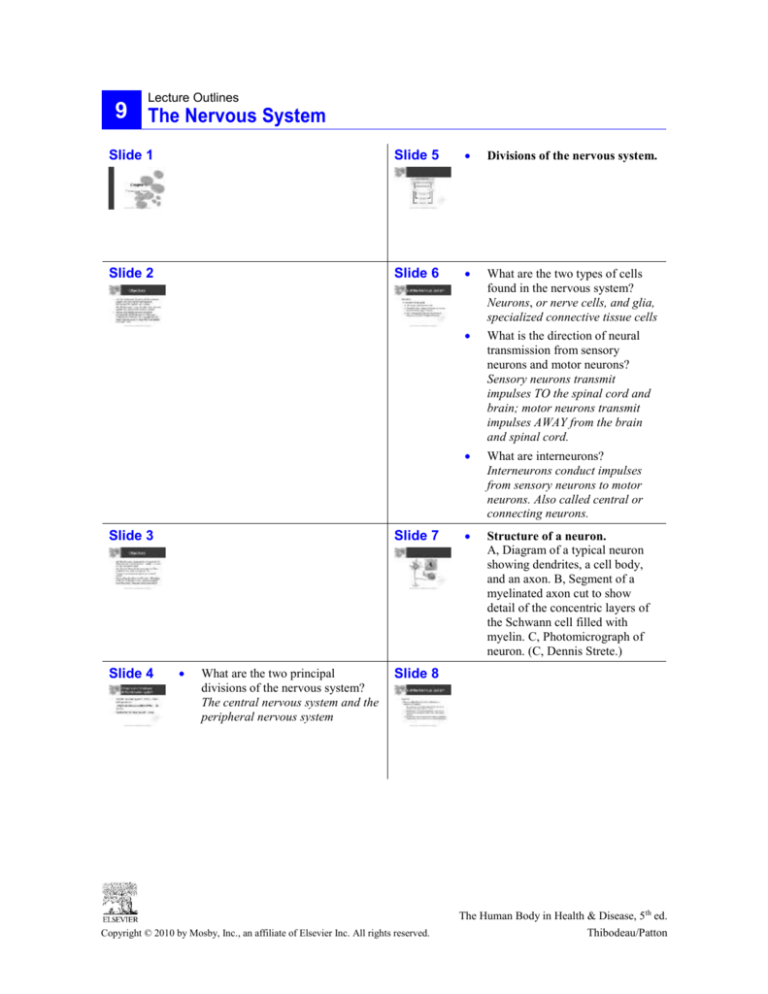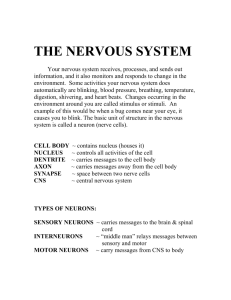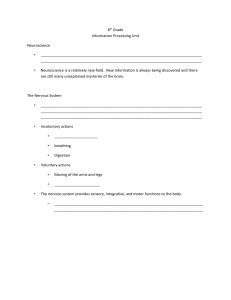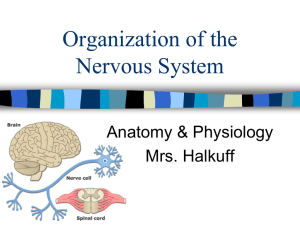
Lecture Outlines
9 The Nervous System
Slide 1
Slide 5
Divisions of the nervous system.
Slide 2
Slide 6
What are the two types of cells
found in the nervous system?
Neurons, or nerve cells, and glia,
specialized connective tissue cells
What is the direction of neural
transmission from sensory
neurons and motor neurons?
Sensory neurons transmit
impulses TO the spinal cord and
brain; motor neurons transmit
impulses AWAY from the brain
and spinal cord.
What are interneurons?
Interneurons conduct impulses
from sensory neurons to motor
neurons. Also called central or
connecting neurons.
Structure of a neuron.
A, Diagram of a typical neuron
showing dendrites, a cell body,
and an axon. B, Segment of a
myelinated axon cut to show
detail of the concentric layers of
the Schwann cell filled with
myelin. C, Photomicrograph of
neuron. (C, Dennis Strete.)
Slide 3
Slide 4
Slide 7
What are the two principal
divisions of the nervous system?
The central nervous system and the
peripheral nervous system
Slide 8
The Human Body in Health & Disease, 5th ed.
Copyright © 2010 by Mosby, Inc., an affiliate of Elsevier Inc. All rights reserved.
Thibodeau/Patton
190
Chapter 9The Nervous System _________________________________________________________
Slide 9
Slide 10
Slide 11
Slide 12
What is the function of glia cells?
Glia cells (Greek for glue) hold the
functioning neurons together,
protect them, and regulate neuron
function.
How are the three types of glia
different? (1) Astrocytes are
relatively large, star-shaped cells
that attach to neurons and small
blood vessels to hold these
structures close to each other.
(2) Microglia usually remain
stationary but in inflammation or
degeneration of the brain, they
enlarge, move about, and act as
microbe-eating scavengers.
(3) Oligodendrocytes help hold
nerve fibers together and also
produce the fatty myelin sheath.
What is myelin? Myelin is a white,
fatty substance.
Slide 13
Multiple neurofibromatosis.
This photo shows multiple tumors
of Schwann cells in the nerves of
the skin that are characteristic of
this inherited condition. (From
Feldman M, Friedman L, Brandt
L: Sleisenger & Fordtran’s
gastrointestinal and liver disease,
ed 8, Philadelphia, 2006,
Saunders.)
Glia. A, Astrocytes have
extensions attached to blood
vessels in the brain. B, Microglia
within the central nervous system
can enlarge and consume
microbes by phagocytosis.
C, Oligodendrocytes have
extensions that form myelin
sheaths around axons in the central
nervous system.
Slide 14
What is white matter composed
of? Nerve fibers usually have a
myelin sheath and myelin is
white.
What is gray matter composed
of? Tissue composed of cell
bodies and unmyelinated axons
and dendrites is called gray
matter because of its
characteristic gray appearance.
Where is myelin produced in the
central nervous system? In
oligodendrocytes.
Slide 15
Where is myelin produced in the
peripheral nervous system? In
Schwann cells.
How might symptoms differ
according to where myelin
production is being impaired?
Symptoms will depend on the nerve
affected as well as the area of the
nerve affected.
The nerve. Each nerve contains
axons bundled into fascicles.
A connective tissue epineurium
wraps the entire nerve.
Perineurium surrounds each
fascicle. Inset shows a scanning
electron micrograph of a cross
section of a nerve. (Micrograph:
Courtesy Dr. Richard Kessel,
Professor of Biological Sciences,
University of Iowa, Iowa City.)
Effects of multiple sclerosis
(MS). A, A normal myelin sheath
allows rapid conduction. B, In
those with MS, the myelin sheath
is damaged, disrupting normal
nerve conduction.
Slide 16
Ask students to describe the
coverings that surround an axon.
The Human Body in Health & Disease, 5th ed.
Copyright © 2010 by Mosby, Inc., an affiliate of Elsevier Inc. All rights reserved.
Thibodeau/Patton
______________________________________________________ Chapter 9The Nervous System
What is the difference between a
neuron pathway and a reflex arc?
A reflex arc is the simplest type of
neuron pathway.
What is a two-neuron arc? The
simplest type of reflex arc
consisting of only two types of
neurons: sensory neurons and
motor neurons.
What is a three-neuron arc? It
consists of three different types of
neurons: sensory neurons, motor
neurons, and interneurons.
What is an effector, and how does
it relate to the reflex arc?
Slide 18
Patellar reflex. The neural
pathway involved in the patellar
(“knee-jerk”) reflex.
Slide 21
Slide 19
Where does impulse conduction
originate? It normally starts in
receptors, the beginnings of
dendrites of sensory neurons.
Slide 22
The end of the sensory neuron’s
axon synapses first with an
interneuron before chemical
signals are sent across a second
synapse, resulting in conduction
through the motor neuron. For
example, application of an
irritating stimulus to the skin of the
thigh initiates a three-neuron reflex
response that causes contraction of
muscles to pull the leg away from
the irritant.
What are some types of stimuli that
initiate nerve impulses? Pressure,
temperature, chemical changes
Slide 17
Slide 20
191
Conduction of nerve impulses.
A, In an unmyelinated fiber, a
nerve impulse (action potential) is
a self-propagating wave of
electrical disturbance. B, In a
myelinated fiber, the action
potential “jumps” around the
insulating myelin in a rapid type
of conduction called saltatory
conduction.
The Human Body in Health & Disease, 5th ed.
Copyright © 2010 by Mosby, Inc., an affiliate of Elsevier Inc. All rights reserved.
Thibodeau/Patton
192
Chapter 9The Nervous System _________________________________________________________
Slide 23
What are the three structures that
make up a synapse? A synaptic
knob, a neurotransmitter, and a
synaptic cleft
How does a nerve impulse travel
from one neuron to another?
Through a synapse via a
neurotransmitter
Slide 24
Slide 25
Ask students to draw a schematic
diagram correctly charting the
following structures and chemicals:
axon terminal, synaptic knob,
presynaptic neuron, postsynaptic
neuron, neurotransmitter, synaptic
cleft, plasma membrane, receptor
molecules.
Components of a synapse.
Diagram shows synaptic knob or
axon terminal of presynaptic
neuron, the plasma membrane of a
postsynaptic neuron, and a synaptic
cleft. On the arrival of an action
potential at a synaptic knob,
neurotransmitter molecules are
released from vesicles in the knob
into the synaptic cleft. The
combining of neurotransmitter and
receptor molecules in the plasma
membrane of the postsynaptic
neuron opens ion channels and
thereby initiates impulse
conduction in the postsynaptic
neuron.
Slide 26
What is a neurotransmitter and
how many are there?
Neurotransmitters are chemicals
by which neurons communicate.
At least 30 different compounds
have been identified as
neurotransmitters.
Name some of the
neurotransmitters. Acetylcholine,
norepinephrine, dopamine,
serotonin, catecholamines
Acetylcholine is released at some
of the synapses in the spinal cord
and at neuromuscular junctions.
Norepinephrine, dopamine, and
serotonin belong to a group of
compounds called
catecholamines, which may play
a role in sleep, motor function,
mood, and pleasure recognition.
Two morphine-like
neurotransmitters called
endorphins and enkephalins are
natural painkillers.
Parkinsonism. Parkinsonism is a
syndrome typically found in
individuals with Parkinson
disease (PD). The signs include
(but are not limited to) rigidity
and trembling of the head and
extremities, a forward tilt of the
trunk, and a shuffling gait with
short steps and reduced arm
swinging. (Rolin Graphics.)
The Human Body in Health & Disease, 5th ed.
Copyright © 2010 by Mosby, Inc., an affiliate of Elsevier Inc. All rights reserved.
Thibodeau/Patton
______________________________________________________ Chapter 9The Nervous System
Slide 27
Slide 28
What are the three main parts of
the brainstem? The medulla
oblongata, pons, and midbrain
Structure—white matter with bits
of gray matter scattered through it.
What is the function of the
brainstem? It functions as a
two-way conduction pathway.
Many important reflex centers
(cardiac, respiratory, and
vasomotor centers – “vital
centers”) are located in the
brainstem.
The nervous system. The brain
and spinal cord (highlighted green)
constitute the central nervous
system (CNS), and the nerves
(yellow) make up the peripheral
nervous system (PNS).
Slide 29
Slide 30
Slide 31
193
What is the structure of the
thalamus? Dumbbell-shaped
section of gray matter above the
hypothalamus.
What is the function of the
thalamus? (1) Helps produce
sensations – relays impulses to
the cerebral cortex from sense
organs; (2) associates sensations
with emotions; (3) plays a part in
the arousal or alerting
mechanism
Major regions of the central
nervous system. A, Sagittal
sections of the brain and spinal
cord. B, Section of preserved
brain. (B, Courtesy Vidic B,
Suarez FR: Photographic atlas of
the human body, St Louis, 1984,
Mosby.)
Slide 32
Slide 33
What is the structure of the
hypothalamus? One of the most
important brain structures. Lies
below thalamus.
What is the function of the
hypothalamus? Manufactures
hormones, part of the mechanism
for maintaining body temperature,
involved in regulation of water
balance, involved in sleep cycle,
involved in control of appetite and
many emotions of pleasure, fear,
anger, sexual arousal, and pain.
Slide 34
The Human Body in Health & Disease, 5th ed.
Copyright © 2010 by Mosby, Inc., an affiliate of Elsevier Inc. All rights reserved.
Thibodeau/Patton
194
Chapter 9The Nervous System _________________________________________________________
Slide 35
Slide 36
Slide 37
What is the lay term for CVA?
Stroke
How would you describe
hemiplegia, paraplegia, triplegia,
quadriplegia, and spastic paralysis?
Hemiplegia – spastic paralysis
of one side of the body;
paraplegia – paralysis of both
legs; triplegia – paralysis of
both legs and one arm;
quadriplegia – paralysis of all four
extremities; paralysis – inability to
initiate voluntary contractions,
may be accompanied by
involuntary contractions of
affected muscles.
What is an EEG? An
electroencephalogram is a graphic
representation of brain activity.
Cerebral palsy (CP). This patient
requires crutches to walk because
abnormal tension (spasticity) in
muscles prevents normal walking
movements. (From Zitelli BJ,
Davis HW: Atlas of pediatric
physical diagnosis, ed 5,
Philadelphia, 2007.)
Slide 38
Alzheimer disease (AD). The
CT scan on the left shows a
horizontal section of a normal
brain. In the CT scan on the right,
however, you can see the dark
patches in the cerebral cortex that
show damage to brain tissue
typical of AD. (James King-Holmes
and Science Photo Library.)
Electroencephalography.
A, Photograph of a person with
voltage-sensitive electrodes
attached to her skull. Information
from these electrodes is used to
produce a graphic recording of
brain activity—an
electroencephalogram (EEG).
B, An EEG tracing showing
activity in four different places in
the brain (obtained from four sets
of electrodes). Compare the
moderate chaotic activity
identified as normal with the
explosive activity that occurs
during a seizure.
Slide 39
Slide 40
The Human Body in Health & Disease, 5th ed.
Copyright © 2010 by Mosby, Inc., an affiliate of Elsevier Inc. All rights reserved.
Thibodeau/Patton
______________________________________________________ Chapter 9The Nervous System
Typically, how long is the spinal
cord? About 17 to 18 inches long.
Distinguish between the spinal
cord and the spinal column. The
spinal cord lies inside the spinal
column in the spinal cavity.
Tracts are functional organizations:
all axons composing one tract
serve a general function.
Other ascending tracts transmit
sensations of touch and pressure to
the brain.
Slide 42
Slide 43
Slide 44
Slide 41
195
Slide 45
Spinal cord and its coverings.
The meninges, spinal nerves, and
sympathetic trunk are all depicted
in this drawing.
Spinal cord and spinal nerves.
Inset is a dissection of the cervical
segment of the spinal cord showing
emerging cervical nerves. The
spinal cord is viewed from behind
(posterior aspect).
Slide 46
Fluid spaces in the brain.
A, The ventricles are highlighted
within the brain in a left lateral
view. B, The ventricles shown
from above.
Spinal cord cross section. Cross
section of the spinal cord showing
the gray matter in the center,
surrounded by white matter
pathways (nerve tracts), and spinal
nerve roots.
Slide 47
Flow of the cerebrospinal fluid.
The fluid produced by filtration
of blood by the choroid plexus of
each ventricle flows inferiorly
through the lateral ventricles,
interventricular foramen, third
ventricle, cerebral aqueduct,
fourth ventricle, and
subarachnoid space and then to
the blood.
Nerve tissue needs to be protected,
so the brain and spinal cord are
surrounded by a tough,
fluid-containing membrane called
the meninges.
Slide 48
The meninges are surrounded by
bone. The spinal meninges form a
tubelike covering around the spinal
cord and line the bony vertebral
foramen of the vertebrae that
surround the cord.
What are some of the structures
included in the peripheral nervous
system? Includes cranial and
spinal nerves that connect the
brain and spinal cord,
respectively, to peripheral
structures such as the skin
surface and the skeletal muscles.
Other structures in the autonomic
nervous system are considered
part of the peripheral nervous
system; they connect the brain
and spinal cord to various glands
in the body and to the cardiac and
smooth muscles in the thorax and
abdomen.
What are the three layers of
the spinal meninges? Dura
mater – tough outer layer that lines
the vertebral canal; arachnoid
mater – membrane between the
dura and pia mater; pia
mater – innermost membrane
covering the spinal cord.
The Human Body in Health & Disease, 5th ed.
Copyright © 2010 by Mosby, Inc., an affiliate of Elsevier Inc. All rights reserved.
Thibodeau/Patton
196
Chapter 9The Nervous System _________________________________________________________
Slide 49
Slide 50
Slide 51
Slide 52
Cranial nerves. View of the
undersurface of the brain shows
attachments of the cranial nerves.
Dermatomes. Segmental
dermatome distribution of spinal
nerves to the front, back, and side
of the body. C, Cervical segments;
T, thoracic segments; L, lumbar
segments; S, sacral segments;
CX, coccygeal segment.
What is the causative agent for
herpes zoster? Varicella zoster
What childhood disease has a
patient contracted to be
susceptible to herpes zoster?
Chickenpox
What is a dermatome? Skin
surface areas supplied by a single
spinal nerve.
Slide 54
Herpes zoster (shingles).
Photograph of a 13-year-old boy
with eruptions involving
dermatome T4 (see Figure 9-24).
(From Habif TP: Clinical
dermatology, ed 2, St. Louis,
1990, Mosby.)
Slide 55
Motor nerves that control the
voluntary actions of skeletal
muscles are sometimes called the
somatic nervous system.
What are the two divisions of the
autonomic nervous system
(ANS)? Sympathetic nervous
system, parasympathetic nervous
system
Spinal nerves conduct impulses
between the spinal cord and parts
of the body not supplied by
cranial nerves.
Spinal nerves function to make
possible sensations and
movements.
Innervation of the major target
organs by the autonomic
nervous system. The sympathetic
pathways are highlighted with
orange, and the parasympathetic
pathways are highlighted with
green.
Slide 53
Slide 56
The Human Body in Health & Disease, 5th ed.
Copyright © 2010 by Mosby, Inc., an affiliate of Elsevier Inc. All rights reserved.
Thibodeau/Patton
______________________________________________________ Chapter 9The Nervous System
Slide 57
Slide 58
What are autonomic effectors?
Tissues to which autonomic
neurons conduct
impulses—cardiac and smooth
muscle and glandular epithelial
tissue.
Autonomic paths to visceral
effectors consist of two-neuron
relays. Impulses travel over
preganglionic neurons from the
spinal cord or brainstem to
autonomic ganglia. There they are
relayed across synapses to
postganglionic neurons, which then
conduct the impulses from the
ganglia to visceral effectors.
In contrast, somatic motor neurons
conduct all the way from the spinal
cord or brainstem to somatic
effectors with no intervening
synapses.
197
Slide 59
Autonomic conduction paths.
A, One somatic motor neuron
conducts impulses all the way
from the spinal cord to a somatic
effector. Conduction from the
spinal cord to any visceral
effector, however, requires a
relay of at least two autonomic
motor neurons—a preganglionic
and a postganglionic neuron (B).
Slide 60
What are the two divisions of the
autonomic nervous system
(ANS)? Sympathetic and
parasympathetic; see
Figure 9-26.
What is the structure of the
sympathetic nervous system?
Also referred to as the
“thoracolumbar system,” it
leaves the spinal cord in the
anterior (ventral) root of a spinal
nerve, enters the spinal nerve, but
soon leaves it to extend to and
through a sympathetic ganglion
and terminate in a collateral
ganglion where it synapses with
several postganglionic neurons
whose axons extend to terminate
in visceral effectors.
The Human Body in Health & Disease, 5th ed.
Copyright © 2010 by Mosby, Inc., an affiliate of Elsevier Inc. All rights reserved.
Thibodeau/Patton
198
Chapter 9The Nervous System _________________________________________________________
Slide 61
Slide 62
What are the functions of the
sympathetic nervous system? It
functions as an emergency system. It
takes control of many internal
organs when we exercise strenuously
and when strong emotions are
elicited. It other words, it functions
during stress. See Table 9-3.
What physiological changes are
associated with the fight-or-flight
response? Heart beats faster, blood
vessels constrict causing blood
pressure to increase, blood vessels
in muscle dilate delivering more
blood to the muscles, sweat glands
and adrenal glands secrete more
abundantly, salivary and other
digestive glands secrete more
sparingly, peristalsis becomes
sluggish, and we are ready for
“flight or flight.”
The sympathetic nervous system
controls visceral effectors during
strenuous exercise and strong
emotions (such as anger, fear, hate,
or anxiety).
Slide 63
What are the functions of the
parasympathetic nervous system,
and how do they differ from the
functions of the sympathetic
nervous system? It dominates
control of many visceral effectors
during normal, everyday
conditions. Impulses tend to slow
heartbeat, increase peristalsis,
and increase secretion of
digestive juices and insulin. See
Table 9-3.
Where are the dendrite and cell
bodies of the sympathetic
preganglionic neurons located? In
the parasympathetic nervous
system in the spinal cord and
brainstem.
Slide 64
What are neurotransmitters?
Chemicals that continue a nervous
impulse through a synapse.
Ask students to offer examples of
neurotransmitters associated with
the ANS, including the division
of the ANS associated with each
neurotransmitter.
Three axons—the sympathetic
preganglionic axon, the
parasympathetic preganglionic
axon, and the parasympathetic
postganglionic axon—release
acetylcholine. These axons are
classified as cholinergic fibers.
Only one type of autonomic axon
releases the neurotransmitter
norepinephrine; this is the axon of
a sympathetic postganglionic
neuron, and such neurons are
classified as adrenergic fibers.
What determines the nature of an
organ’s response to stimulation by
the autonomic nervous system?
Cholinergic and adrenergic fibers
The Human Body in Health & Disease, 5th ed.
Copyright © 2010 by Mosby, Inc., an affiliate of Elsevier Inc. All rights reserved.
Thibodeau/Patton
______________________________________________________ Chapter 9The Nervous System
Slide 65
Slide 66
Autonomic neurotransmitters.
Three of the four fiber types are
cholinergic, secreting the
neurotransmitter acetylcholine
(Ach) into a synapse. Only the
sympathetic 4. What problems in
the body arise from ANS
malfunctions? Postganglionic fiber
is adrenergic, secreting
norepinephrine (NE) into a
synapse.
199
Slide 67
Slide 68
What are examples of
stress-induced diseases? Heart
disease, ulcers, colitis,
autoimmune disorders, and a
depressed immune system
resulting in infections, colds, etc.
Stress can oversecrete gastric
hydrochloric acid.
The Human Body in Health & Disease, 5th ed.
Copyright © 2010 by Mosby, Inc., an affiliate of Elsevier Inc. All rights reserved.
Thibodeau/Patton









